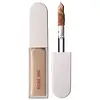What's inside
What's inside
 Key Ingredients
Key Ingredients

 Benefits
Benefits

 Concerns
Concerns

No concerns
 Ingredients Side-by-side
Ingredients Side-by-side

Aloe Barbadensis Leaf Juice
Skin ConditioningDicaprylyl Carbonate
EmollientButylene Glycol
HumectantButyrospermum Parkii Butter
Skin ConditioningPolyglyceryl-3 Polyricinoleate
EmulsifyingDodecane
PerfumingOryza Sativa Powder
Oryza Sativa Bran Oil
EmollientVegetable Oil
Skin ConditioningHelianthus Annuus Seed Wax
Skin ConditioningOryza Sativa Bran Wax
Skin ConditioningRhus Succedanea Fruit Wax
Polyglyceryl-3 Diisostearate
EmulsifyingGlycerin
HumectantSodium PCA
HumectantSodium Chloride
MaskingXanthan Gum
EmulsifyingSodium Dehydroacetate
PreservativeLactic Acid
BufferingGlycolipids
Skin ConditioningHydrolyzed Hyaluronic Acid
HumectantSodium Hyaluronate
HumectantAscorbyl Palmitate
AntioxidantTocopherol
AntioxidantAluminum Hydroxide
EmollientPaeonia Lactiflora Root Extract
Skin ConditioningVaccinium Myrtillus Fruit Extract
Skin ConditioningCI 77891
Cosmetic ColorantMica
Cosmetic ColorantCI 77491
Cosmetic ColorantCI 77492
Cosmetic ColorantCI 77499
Cosmetic ColorantCI 77288
Cosmetic ColorantAloe Barbadensis Leaf Juice, Dicaprylyl Carbonate, Butylene Glycol, Butyrospermum Parkii Butter, Polyglyceryl-3 Polyricinoleate, Dodecane, Oryza Sativa Powder, Oryza Sativa Bran Oil, Vegetable Oil, Helianthus Annuus Seed Wax, Oryza Sativa Bran Wax, Rhus Succedanea Fruit Wax, Polyglyceryl-3 Diisostearate, Glycerin, Sodium PCA, Sodium Chloride, Xanthan Gum, Sodium Dehydroacetate, Lactic Acid, Glycolipids, Hydrolyzed Hyaluronic Acid, Sodium Hyaluronate, Ascorbyl Palmitate, Tocopherol, Aluminum Hydroxide, Paeonia Lactiflora Root Extract, Vaccinium Myrtillus Fruit Extract, CI 77891, Mica, CI 77491, CI 77492, CI 77499, CI 77288
Water
Skin ConditioningC9-12 Alkane
SolventGlycerin
HumectantPropanediol
SolventTribehenin
EmollientPentylene Glycol
Skin ConditioningPolyglyceryl-3 Polyricinoleate
EmulsifyingSorbitan Isostearate
EmulsifyingDisteardimonium Hectorite
StabilisingCaprylic/Capric Triglyceride
MaskingCoco-Caprylate/Caprate
EmollientSqualane
EmollientRanunculus Ficaria Extract
Skin ConditioningAcmella Oleracea Extract
Skin ProtectingSodium Hyaluronate
HumectantLysine
Skin ConditioningTocopherol
AntioxidantMagnesium Chloride
Aluminum Hydroxide
EmollientGlyceryl Caprylate/Caprate
EmollientSodium Lauroyl Glutamate
CI 77891
Cosmetic ColorantIron Oxides
Water, C9-12 Alkane, Glycerin, Propanediol, Tribehenin, Pentylene Glycol, Polyglyceryl-3 Polyricinoleate, Sorbitan Isostearate, Disteardimonium Hectorite, Caprylic/Capric Triglyceride, Coco-Caprylate/Caprate, Squalane, Ranunculus Ficaria Extract, Acmella Oleracea Extract, Sodium Hyaluronate, Lysine, Tocopherol, Magnesium Chloride, Aluminum Hydroxide, Glyceryl Caprylate/Caprate, Sodium Lauroyl Glutamate, CI 77891, Iron Oxides
 Reviews
Reviews

Ingredients Explained
These ingredients are found in both products.
Ingredients higher up in an ingredient list are typically present in a larger amount.
Aluminum Hydroxide is a form of aluminum. It can be naturally found in nature as the mineral gibbsite. In cosmetics, Aluminum Hydroxide is used as a colorant, pH adjuster, and absorbent.
As a colorant, Aluminum Hydroxide may add opacity, or reduce the transparency. Aluminum hydroxide is contains both basic and acidic properties.
According to manufacturers, this ingredient is an emollient and humectant. This means it helps hydrate the skin.
In medicine, this ingredient is used to help relieve heartburn and help heal ulcers.
There is currently no credible scientific evidence linking aluminum hydroxide in cosmetics to increased cancer risk.
Major health organizations allow the use of aluminum hydroxide in personal care products and have not flagged it as a carcinogenic risk at typical usage levels.
Learn more about Aluminum HydroxideCi 77891 is a white pigment from Titanium dioxide. It is naturally found in minerals such as rutile and ilmenite.
It's main function is to add a white color to cosmetics. It can also be mixed with other colors to create different shades.
Ci 77891 is commonly found in sunscreens due to its ability to block UV rays.
Learn more about CI 77891Glycerin is already naturally found in your skin. It helps moisturize and protect your skin.
A study from 2016 found glycerin to be more effective as a humectant than AHAs and hyaluronic acid.
As a humectant, it helps the skin stay hydrated by pulling moisture to your skin. The low molecular weight of glycerin allows it to pull moisture into the deeper layers of your skin.
Hydrated skin improves your skin barrier; Your skin barrier helps protect against irritants and bacteria.
Glycerin has also been found to have antimicrobial and antiviral properties. Due to these properties, glycerin is often used in wound and burn treatments.
In cosmetics, glycerin is usually derived from plants such as soybean or palm. However, it can also be sourced from animals, such as tallow or animal fat.
This ingredient is organic, colorless, odorless, and non-toxic.
Glycerin is the name for this ingredient in American English. British English uses Glycerol/Glycerine.
Learn more about GlycerinThis ingredient is an emulsifier. It is created from Polyglycerin-3 and Ricinoleic Acid.
As an emulsifier, it prevents waters and oils from separating. According to a manufacturer this ingredient is fully biodegradable.
This ingredient may not be safe for Malassezia folliculitis due to its Ricinoleic Acid base. Ricinoleic Acid is a fatty acid derived from castor oil.
Learn more about Polyglyceryl-3 PolyricinoleateSodium Hyaluronate is hyaluronic acid's salt form. It is commonly derived from the sodium salt of hyaluronic acid.
Like hyaluronic acid, it is great at holding water and acts as a humectant. This makes it a great skin hydrating ingredient.
Sodium Hyaluronate is naturally occurring in our bodies and is mostly found in eye fluid and joints.
These are some other common types of Hyaluronic Acid:
Learn more about Sodium HyaluronateTocopherol (also known as Vitamin E) is a common antioxidant used to help protect the skin from free-radicals and strengthen the skin barrier. It's also fat soluble - this means our skin is great at absorbing it.
Vitamin E also helps keep your natural skin lipids healthy. Your lipid skin barrier naturally consists of lipids, ceramides, and fatty acids. Vitamin E offers extra protection for your skin’s lipid barrier, keeping your skin healthy and nourished.
Another benefit is a bit of UV protection. Vitamin E helps reduce the damage caused by UVB rays. (It should not replace your sunscreen). Combining it with Vitamin C can decrease sunburned cells and hyperpigmentation after UV exposure.
You might have noticed Vitamin E + C often paired together. This is because it is great at stabilizing Vitamin C. Using the two together helps increase the effectiveness of both ingredients.
There are often claims that Vitamin E can reduce/prevent scarring, but these claims haven't been confirmed by scientific research.
Learn more about Tocopherol